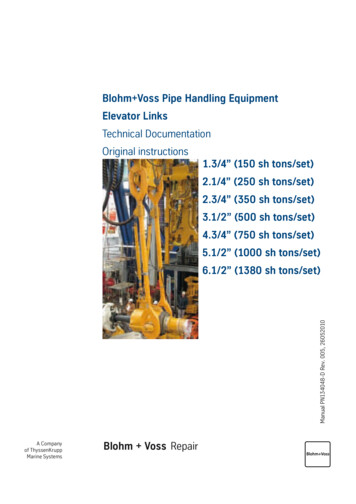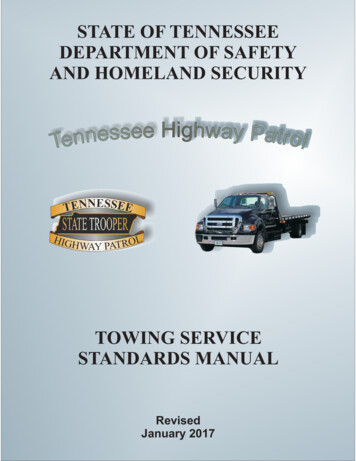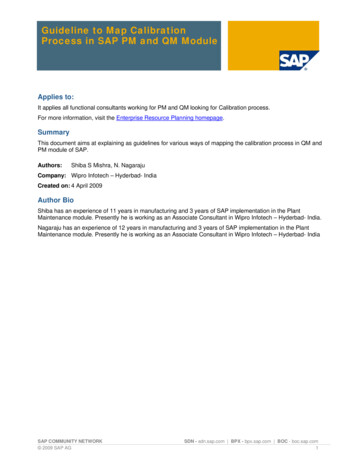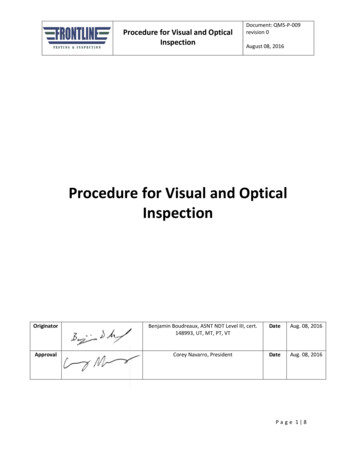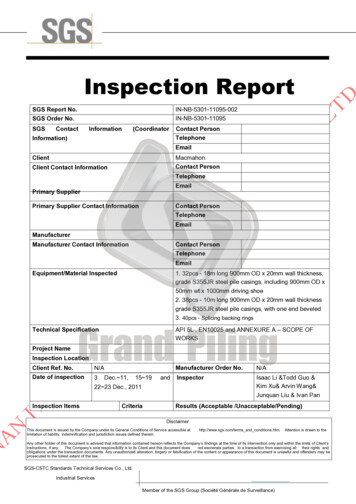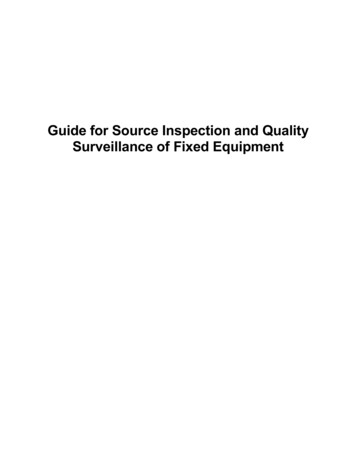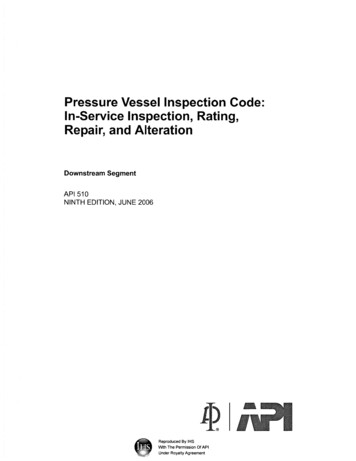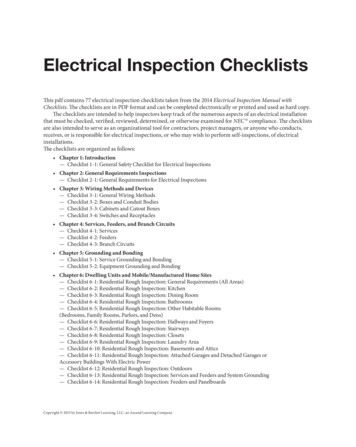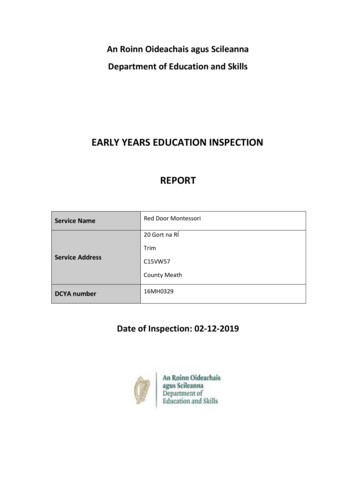
Transcription
An Roinn Oideachais agus ScileannaDepartment of Education and SkillsEARLY YEARS EDUCATION INSPECTIONREPORTService NameRed Door Montessori20 Gort na RÍTrimService AddressC15VW57County MeathDCYA number16MH0329Date of Inspection: 02-12-2019
WHAT IS AN EARLY YEARS EDUCATION INSPECTION?The Early Years Education Inspection (EYEI) model is used to provide evaluative information, adviceand support in relation to education provision in a pre-school service participating in the Early ChildhoodCare and Education (ECCE) Programme. These inspections affirm good practice and advise actions,where appropriate, to aid the further development of education provision in the service.HOW TO READ THIS REPORTDuring this inspection, the inspector evaluated and reported under the following headings or areas ofenquiry:1.2.3.4.Quality of the context to support children’s learning and developmentQuality of processes to support children’s learning and developmentQuality of children’s learning experiences and achievementsQuality of management and leadership for learningInspectors describe the quality of each of these areas using the Inspectorate’s quality continuum whichis shown on the final page of this report. The quality continuum provides examples of the language usedby inspectors when evaluating and describing the quality of the service’s provision in each area.1
Early Years Education InspectionDate of inspection02-12-2019Inspection activities undertaken Pre-inspection meeting with the settingowner/practitionerDiscussion with the early years practitionerObservation of interactions and activities duringa pre-school session Interaction and discussion with the childrenReview of relevant setting documentationReview of records of the children’s learning anddevelopmentPost-inspection feedback discussion with thesetting owner/practitioner and early yearspractitionerCONTEXT OF SERVICERed Door Montessori, established over twelve years ago, provides a morning sessional pre-schoolprogramme for ten children enrolled on the Early Childhood Care and Education (ECCE) Programme.The owner/practitioner, an early years practitioner and eight children were present on the day on theinspection. The early years setting was given an opportunity to comment in writing on the findings andactions advised of the report; the setting chose to accept the report without response.AREA 1QUALITY OF CONTEXT TO SUPPORT CHILDREN’S LEARNING AND DEVELOPMENT The quality of the context to support the children’s learning and development is excellent.There is a notably warm and welcoming atmosphere in this setting. Families are greeted warmlyand time is taken to share information and have unhurried conversations at arrival and home times.Relationships between the practitioner and the children are commendably secure and positive.Interactions between the practitioner and the children are characterised by gentleness andpositivity. The children are respected as individuals and they hear many positiveacknowledgements of their ideas and achievements from the practitioners.There is a daily routine in place which allocates substantial time to child-selected play and learningactivities. There is a snack time, outside time and time for practitioner-planned and facilitatedactivities which children can choose to engage in.Transitions are announced by the practitioners and signalled using timers.Snack time is a relaxed and social occasion where children engage in animated and excitedconversation on topics that are of interest to them.The children’s developing sense of identity and belonging is very effectively supported by thepractitioners. They engage in frequent conversations with the children about themselves, theirfamilies and their life experiences. There are photographs of the children displayed in the roomand these are used to identify their cubby and hooks. Parents often visit the setting to spend timeand to read stories. They also attend events and celebrations organised throughout the pre-schoolyear.AREA 2QUALITY OF PROCESSES TO SUPPORT CHILDREN’S LEARNING ANDDEVELOPMENT The quality of the processes to support the children’s learning and development is very good.The setting implements a play-based curriculum which is fully aligned to the principles of Aistear:The Early Childhood Curriculum Framework. A list of learning dispositions is displayed in thesetting to support the practitioners’ reflection on the children’s play and learning. Aspects of theMontessori approach have been successfully integrated into this play-based curriculum.The practitioners engage in long, medium and short-term planning for the curriculum. Planning ispredominantly topic and thematically based. These plans are changed if they do not engage thechildren’s interest. The practitioners are observing and noting the children’s emerging interestsand are beginning to informally plan to support and extend these. On the day of the inspection,2
the practitioner introduced a Christmas elf into the room. The children spoke eagerly and often,throughout the session about their own elves and their names. The practitioners responded to thisshared interest. They decided that they would invite the children’s elves to visit the pre-school onFriday and made a note to send a message to parents.The practitioners record a very wide range of observations of the children’s learning andachievements in individual learner journals and in a mark-making scrap book. These recordsportray a rich picture of each child’s individual learning journey.The indoor learning environment provides for a wide range of play and learning opportunities.Resources and material are well-matched to the children’s developmental levels and interests.The outdoor learning environment is a natural space and provides areas for physical and grossmotor play. There is potential to expand the range of play opportunities outdoors.The practitioners utilise highly effectively strategies to support the children’s learning anddevelopment through play. They remained focused on the children throughout the session,working at their physical levels, joining in as a play partner and encouraging and prompting thechildren to think at a deeper level about their play and ideas.Support for the children’s early literacy and numeracy skills development is commendable. Thepractitioners use songs and rhymes throughout the session. They introduce new songs andrhymes regularly. They talk about numbers and mathematical concepts when playing. On the dayof the inspection, children were discussing ages and numbers. The practitioner then introducedthe Montessori sand paper numbers and the children discussed them, played with them andplaced them in order.The children are learning in an inclusive environment. The setting is linked with the Better StartAccess and Inclusion Model (AIM) to access assessment and support for children with possibleadditional needs.Actions advised The practitioners are advised to begin to involve the children in planning for their learning.Engaging the children in discussion about their current interests, establishing what they knowalready and what they would like to learn, find out and discover will assist in this regard. It is advised that the practitioners continue to enrich the indoor and outdoor learning environments.The introduction outdoors, of loose, open-ended real materials and props for large constructionand building would greatly support the children’s physical development and extend their strongcurrent interest in construction. Use of the self-evaluation tool in the Aistear, Síolta Practice Guide,‘Creating and using the learning environment’ will greatly support this action.AREA 3QUALITY OF CHILDREN’S LEARNING EXPERIENCES AND ACHIEVEMENTS The quality of the children’s learning experiences and achievements is very good.The children are very well-settled in the setting. They display a strong sense of belonging in thegroup.During the extended free play time, the children were notably focused and engaged in their selfselected activities. They are making many choices and decisions about their play and learning.The children are communicating their experiences, thoughts and interests in many ways. One childstated that he was going to paint his mammy and daddy under the sea and did. Two childrenengaged in prolonged socio-dramatic play centred on nurturing babies. Many children recountedstories of things that had happened at home to practitioners and to their peers.There are many friendships among the children. They are notably gentle, kind and respectful ofeach other.The children are developing independence and good self-care skills. They delight in being theclass weekly helper and respond to the task assigned with great pride and responsibility.The children are developing good early literacy and numeracy skills. They enjoy playing withnumbers and using mathematical language. It was observed that there is potential to introducereal resource and props to support literacy and numeracy play.Many children are developing the skills required to play games with rules that involve turn taking.Many other children work well with peers to complete tasks together, such as making a new‘difficult’ puzzle.The children are experiencing achievement and are learning in line with their individual capabilities.3
Actions advised To further nurture the children’s desire to take responsibility for tasks, it is advised that thepractitioners develop a visual jobs board that allocates each child a job each day. These can berotated daily. It is advised that practitioners increase the access and range of resources and real props tosupport the development of the children’s early numeracy and literacy skills.AREA 4QUALITY OF M ANAGEMENT AND LEADERSHIP FOR LEARNING The quality of management and leadership for learning is very good.There is a highly professional ethos in this setting. The practitioners hold a shared vision for thechildren’s learning and development in the ECCE programme. They recognised the importance ofnurturing positive learning dispositions in the early years. Documentation of this curriculumapproach would support planning and assessment and provide valuable information for parents.The staff review and plan for the curriculum programme informally and regularly.There is a very strong sense of respectful and positive teamwork in the setting. Roles andresponsibilities are clear and equitable. The practitioners share leadership roles throughout thesession.Information about the setting is highly effectively shared with parents through a variety of methods,including a comprehensive handbook which is emailed to each parent, a social media applicationgroup, a broadcast application and daily conversations.The children’s individual journals and mark-making books are sent home for parents to reviewevery month. Facilitating parents to add reflections and comments to this journal would enhancecurrent provision.The owner has established good professional relationships with the local primary schools. Theprinciple from one school makes contact to share information before the children transition. Theowner completes a brief positive developmental summary for each child which parents areencouraged to share with their child’s primary school teacher.Actions advised It is advised that the staff formalise the ECCE programme by documenting the broad-basedcurriculum goals, informed by Aistear, which underpin the ECCE curriculum programme. The practitioners are advised to use the online Aistear, Síolta Practice Guide to formalise anddocument the review and self-reflection processes of the pre-school. It is advised that the practitioners invite parents and family members to add reflections andcomments to their child’s learner journal when it is shared each month. To further support the children’s transition to primary school, it is advised that the practitionersbegin to explore using the ‘Mo Scéal’ learner profiles available at www.ncca.ie.4
Summary of Overall InspectionAreaQuality LevelQuality of context to support children’s learning and developmentExcellentQuality of processes to support children’s learning anddevelopmentVery goodQuality of children’s learning experiences and achievementsVery goodQuality of management and leadership for learningVery goodLanguage used in Early Years Education Inspection reportsExcellentProvision that is excellent is exemplary in meeting the needs ofchildren.Very goodProvision that is very good is highly effective in meeting the needsof children.GoodProvision that is good is effective in meeting the needs of childrenbut with some aspects to be developed.FairProvision that is fair requires practice to be improved to meet theneeds of children.PoorProvision that is poor is inadequate and requires significantimprovement to meet the needs of children.Published February 20205
stated that he was going to paint his mammy and daddy under the sea and did. Two children engaged in prolonged socio-dramatic play centred on nurturing babies. Many children recounted stories of things that had happened at home to practitioners and to their peers. There are many friendships among the children.
